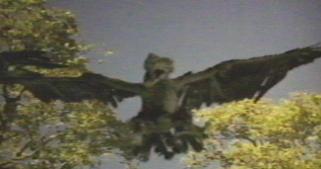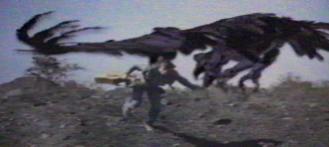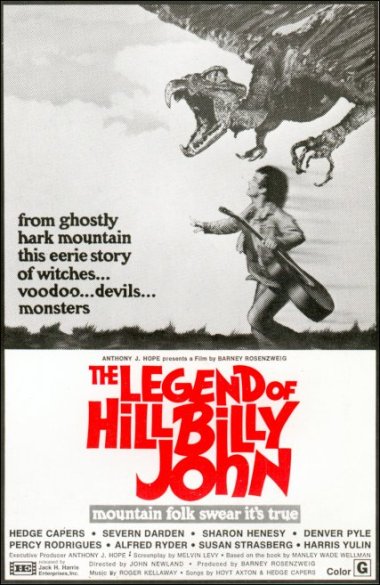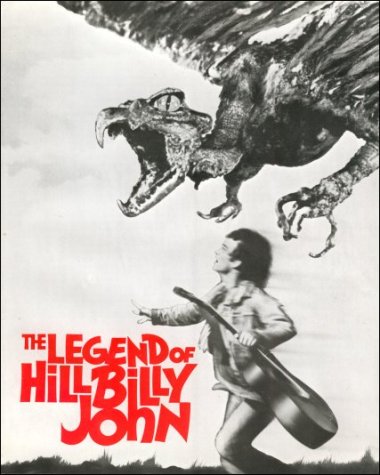
May 12, 2006
Wisconsin writer and investigator Todd Roll has discovered an early forgotten, overlooked film that coincidentally appeared as a precursor to the famous Thunderbird flap in the 1970s.

The movie was released in 1974, and entitled The Legend of Hillbilly John. Three years later, with the attempted airborne abduction of Marlon Lowe by two giant birds at Lawndale, Illinois, on July 25, 1977, the modern era of Thunderbird sightings began. The first investigator on the scene was my brother, Jerry, and the first write-up of the case came from his rough notes in Creatures of the Outer Edge.

Based on a book of Appalachian Mountain folktales by Manly Wade Wellman, The Legend of Hillbilly John’s plot involves a wandering ballad singer in the Appalachians who is terrorized by a giant bird. This film may be evidence of the cryptofictional reflection of those earlier stories as noted in Mark A. Hall’s Thunderbirds: America’s Living Legends of Giant Birds, in his chapter, “Mystery of the Balds,” about the old big bird traditions that then were fictionalized in Wellman’s book. One can measure a circle, beginning anywhere.

The film has the look of a made-for-television compilation, and this is probably because it was directed by John Newland. Newland was a well-known 1950s-1970s TV director (“Wonder Woman,” “Boris Karloff’s Thriller,” “Police Woman,” “Hawaii 5-0,” “Night Gallery”) who served as a frequent on-camera host for early 1950s’ television series like “Alcoa Presents: One Step Beyond” and “Tales of Tomorrow.” But as opposed to this film going straight to the smaller screen, it ended up playing the drive-in movie circuit in the South and Midwest in the mid-1970s.
The Legend of Hillbilly John has as its most well-known actor Denver Pyle (1920-1997), who played “Grandpappy John” in the film. Susan Strasberg, a friend of Marilyn Monroe’s and the daughter of Lee Strasberg, played “Polly White.”
The film is populated with people who were foundation television actors of their day. In the movie there is one pivotal character that is in control of the giant “Ugly Bird,” that would be the evil “O.J. Onselm” (played by Alfred Ryder). Onselm’s minion, the Ugly Bird, is only destroyed when Hillbilly John (Hedges Caper) plays the song El Kabong (passed on to him from Grandpappy John) on the Ugly Bird’s head, causing it to melt and Onselm to shrivel and die.
Playing the “degrees of separation” game with this one actor, via the IMDb credits, I found some intriguing results. Character actor Alfred Ryder, who played “O. J. Onselm,” is the brother of Olive Deering. Deering was known as one of the so-called “Queens of the Golden Age of Live Television,” and had been married to Leo Penn, until 1952. Penn, who was blacklisted during the McCarthy era, moved on to marry Eileen Ryan that same year, in 1952. Penn and Ryan are the parents of actor/director Sean Penn, the late actor Chris Penn, and musician Michael Penn. Michael Penn is married to songwriter and musician Aimee Mann, who did most of the songs for the 1999 motion picture Magnolia. Magnolia is one of the most Fortean films made in recent years, ending with a long scene of falling frogs. I couldn’t find a link between The Legend of Hillbilly John and The Mothman Prophecies, but I almost got there.

As one contemporary reviewer on the “Bad Movie Report” site noted:
You can’t judge The Legend of Hillbilly John as you would standard drive-in or B-movie fare – it’s that rarity, a sorta thoughtful film. In true 1972 style, it wears it’s politics painfully on its sleeve a time or two, with its “highways & dams = evil” pretensions, and the rather suspect hailing of John as a hero by the black cotton pickers simply because he brought the guitar (it’s the outspoken black worker who actually does in Captain Lajoie while the villain is choking the guitarless-and-therefore-helpless John). But all that aside, the closing image is damn clever. My aging hippie heart embraces it.
Directed by John Newland – the host of One Step Beyond for all you oldsters – Hillbilly John treats its subject matter fairly matter of factly, by which I mean after a few jarring instances, we fall into the arcane sentence structure and belief systems of the backwoods pretty easily. The cinematography is handsome enough, showcasing some beautiful scenery, and the editing and camera placement is fairly spot on. The major problem we have here is budget, pure and simple. Newland has overcome it well in a couple of instances: entering the cotton plantation through enormous yellow gates, everything is tinted yellow until Lajoie’s death; and as Grandpappy John sings the ultimate line of “The Defy” (written by Hoyt Axton, no less), his death is symbolized by the film breaking. It’s an audacious, arty moment, and deserving of applause.
As a political, cultural, and cryptozoological foreshadowing of the series of Thunderbird sightings that occurred in Illinois in the 1970s, I guess no one could have wished for better cinema.

About Loren Coleman
Loren Coleman is one of the world’s leading cryptozoologists, some say “the” leading living cryptozoologist. Certainly, he is acknowledged as the current living American researcher and writer who has most popularized cryptozoology in the late 20th and early 21st centuries.
Starting his fieldwork and investigations in 1960, after traveling and trekking extensively in pursuit of cryptozoological mysteries, Coleman began writing to share his experiences in 1969. An honorary member of Ivan T. Sanderson’s Society for the Investigation of the Unexplained in the 1970s, Coleman has been bestowed with similar honorary memberships of the North Idaho College Cryptozoology Club in 1983, and in subsequent years, that of the British Columbia Scientific Cryptozoology Club, CryptoSafari International, and other international organizations. He was also a Life Member and Benefactor of the International Society of Cryptozoology (now-defunct).
Loren Coleman’s daily blog, as a member of the Cryptomundo Team, served as an ongoing avenue of communication for the ever-growing body of cryptozoo news from 2005 through 2013. He returned as an infrequent contributor beginning Halloween week of 2015.
Coleman is the founder in 2003, and current director of the International Cryptozoology Museum in Portland, Maine.
Filed under Books, Breaking News, Cryptotourism, CryptoZoo News, Cryptozoology, Eyewitness Accounts, Folklore, Forensic Science, Media Appearances, Movie Monsters, Pop Culture, Reviews, Television, Thunderbirds